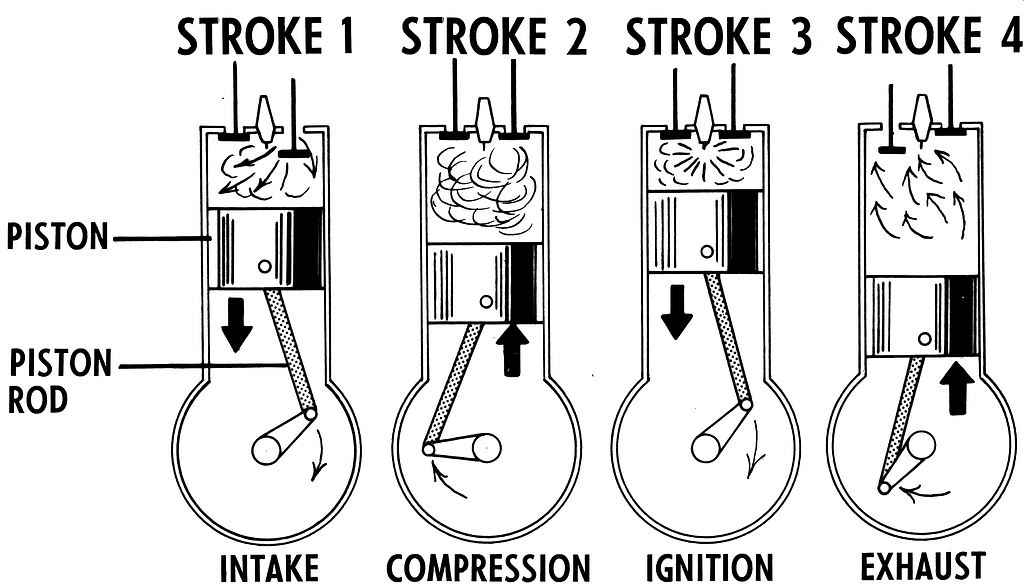Performance Of Ci Engines
The performance of CI (Compression Ignition) engines, commonly known as diesel engines, is influenced by various factors and can be evaluated based on several key parameters. Below are some of the main aspects that affect and determine the performance of CI engines:

1. Thermal Efficiency
-
Higher Compression Ratio: CI engines typically operate at higher compression ratios (around 14:1 to 25:1) compared to SI (Spark Ignition) engines. This higher compression ratio improves thermal efficiency, making diesel engines more efficient in converting fuel into useful work.
-
Heat Loss: CI engines tend to have lower heat losses due to better thermal insulation, which contributes to their overall efficiency.
-
Thermal efficiency () of a CI engine is an important measure of how effectively the engine converts the energy in fuel into useful work. The thermal efficiency is given by:
- is the compression ratio.
- is the cutoff ratio (the ratio of the volume after combustion to the volume before combustion).
- is the adiabatic index or ratio of specific heats .
2. Fuel Efficiency
- Energy Density: Diesel fuel has a higher energy density compared to gasoline, which means it provides more energy per unit of fuel. This contributes to better fuel efficiency and longer driving ranges.
- Specific Fuel Consumption (SFC): CI engines generally have lower specific fuel consumption, meaning they use less fuel to generate the same amount of power compared to SI engines.
-
Where:
-
is the mass flow rate of the fuel (in kg/s).
-
is the power output of the engine (in kW).
-
3. Torque and Power Output
-
High Torque at Low RPM: Diesel engines are known for their high torque output, especially at low RPMs. This characteristic makes them ideal for heavy-duty applications like trucks, buses, and industrial machinery.
-
Power Density: Although CI engines may have lower peak power outputs compared to SI engines of similar displacement, their torque characteristics often make them more suitable for applications requiring consistent power over long durations.
-
The power output of a CI engine is related to the torque and engine speed by:
Where:
- is in watts (W).
- is the engine speed in revolutions per minute (RPM).
- is the torque in newton-meters (Nm).
4. Emissions and Environmental Impact
- NOx and Particulate Emissions: CI engines produce higher levels of nitrogen oxides (NOx) and particulate matter (PM) compared to SI engines. However, modern diesel engines are equipped with advanced after-treatment systems like Selective Catalytic Reduction (SCR) and Diesel Particulate Filters (DPF) to meet stringent emission standards.
- Carbon Dioxide (CO2) Emissions: Due to their higher fuel efficiency, CI engines tend to emit less CO2 per kilometer driven compared to SI engines, which can be beneficial from a climate change perspective.
5. Reliability and Durability
- Engine Longevity: CI engines are typically more robust and durable due to their design, which includes stronger components to handle the higher compression ratios and combustion pressures.
- Maintenance: While CI engines are generally reliable, they may require more frequent maintenance of components like fuel injectors and turbochargers.
6. Noise and Vibration
- NVH Levels: CI engines are generally noisier and have higher vibration levels compared to SI engines. However, advancements in engine design and materials have helped reduce noise, vibration, and harshness (NVH) in modern diesel engines.
7. Cold Start Performance
- Glow Plugs: CI engines may struggle with cold starts due to the high compression and low temperatures, which can impede fuel ignition. Glow plugs are used to preheat the combustion chamber to aid in cold starts.
8. Applications
- Heavy-Duty Vehicles: Due to their high torque output and fuel efficiency, CI engines are commonly used in trucks, buses, marine vessels, and heavy machinery.
- Light-Duty Vehicles: Diesel engines are also used in some passenger cars, especially in regions where fuel efficiency is prioritized.
CI engines are characterized by their high thermal efficiency, fuel efficiency, and torque output, making them suitable for heavy-duty applications. However, they face challenges related to emissions and NVH levels. With ongoing advancements in technology, modern CI engines continue to improve in terms of performance, emissions control, and overall refinement.